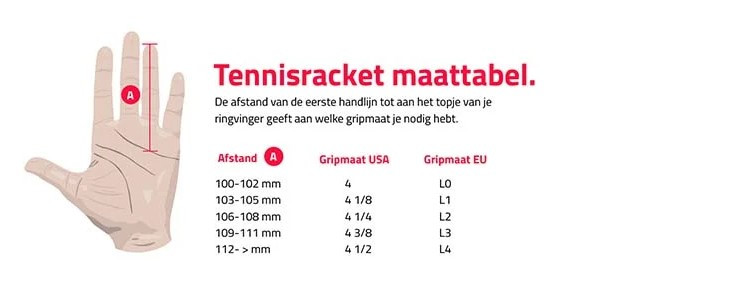Passion for Sports
Worldwide delivery
Call us:+31 416 293012
Help in choosing the right tennisracket
Does my playing strength affect my choice of racket?
We distinguish between 4 ranges of playing strengths. Certain racket characteristics are often chosen for these ranges. For example, the weight, size of the racket blade and balance point depend on the level at which you play.
Playing strength 1/2/3: This group of players is often looking for a heavier racket which gives a lot of control. A player in this category can master all strokes with the right technique. Men's rackets weigh around 310 grams or more. Women's rackets weigh 295 grams or more. The blade is often smaller (±630 cm²) and the balance point is towards the handle (±310 mm).
Playing strength 3/4/5: This group of players is often looking for a racket that provides a good mix of power and control. The racket they use weighs between 290 and 310 grams. The blade varies between 630 and 645 cm². The balance point is towards the handle (±320 mm).
Playing strength 5/6/7: This group of players is often looking for a racket that gives a little more power than control. The racket they use weighs between 275 and 300 grams. The blade varies between 645 and 671 cm². The racket is usually even-balanced (±330 mm).
Playing strength 7/8/9: This group of players is often looking for a racket that provides a lot of power and comfort. The racket used weighs between 255 and 275 grams. The blade is often larger than 671 cm². The balance point of these rackets is always at the top of the racket (±330 mm).
Playing strength 1/2/3: This group of players is often looking for a heavier racket which gives a lot of control. A player in this category can master all strokes with the right technique. Men's rackets weigh around 310 grams or more. Women's rackets weigh 295 grams or more. The blade is often smaller (±630 cm²) and the balance point is towards the handle (±310 mm).
Playing strength 3/4/5: This group of players is often looking for a racket that provides a good mix of power and control. The racket they use weighs between 290 and 310 grams. The blade varies between 630 and 645 cm². The balance point is towards the handle (±320 mm).
Playing strength 5/6/7: This group of players is often looking for a racket that gives a little more power than control. The racket they use weighs between 275 and 300 grams. The blade varies between 645 and 671 cm². The racket is usually even-balanced (±330 mm).
Playing strength 7/8/9: This group of players is often looking for a racket that provides a lot of power and comfort. The racket used weighs between 255 and 275 grams. The blade is often larger than 671 cm². The balance point of these rackets is always at the top of the racket (±330 mm).
Are you looking for power, control, comfort or spin?
To determine whether you need a racket with power, control, comfort or spin, we have outlined the characteristics of these types for you.
Power: If you are looking for rackets with a thicker frame and a large sweet spot (= the ideal place to hit the ball, in the middle of the racket), you will choose power. A power racket often has a larger blade, so the sweet spot is bigger. The rackets are not as stiff as a control racket and therefore easily give momentum to the ball.
Control: If you are looking for the feeling needed for placing the ball, you should choose a control racket. Control rackets are a bit heavier and have a smaller blade and also feel a bit stiffer. Control rackets often have a denser string pattern, or more strings in the racket. This ensures a longer life of the string and the strings are less likely to slide. These rackets always have a narrower frame than a racket that gives power, for example.
Comfort: If you are looking for a comfortable racket, often suitable for playing strength 7 to 9, you should choose comfort. These rackets are lighter in weight and have a larger sweet spot. The light weight of the racket makes it easy to manoeuvre and use. Players who are prone to injuries can also choose a comfort racket.
Spin: If you are looking for a racket that allows you to spin optimally, choose a larger blade size. This makes the sweet spot (= the ideal place to hit the ball, in the middle of the racket) larger than an average racket and can give extra spin to the ball. Spin rackets often have an open string pattern, because the strings are further apart the strings can move more. This allows you to play more with effect (top spin and slice).
Power: If you are looking for rackets with a thicker frame and a large sweet spot (= the ideal place to hit the ball, in the middle of the racket), you will choose power. A power racket often has a larger blade, so the sweet spot is bigger. The rackets are not as stiff as a control racket and therefore easily give momentum to the ball.
Control: If you are looking for the feeling needed for placing the ball, you should choose a control racket. Control rackets are a bit heavier and have a smaller blade and also feel a bit stiffer. Control rackets often have a denser string pattern, or more strings in the racket. This ensures a longer life of the string and the strings are less likely to slide. These rackets always have a narrower frame than a racket that gives power, for example.
Comfort: If you are looking for a comfortable racket, often suitable for playing strength 7 to 9, you should choose comfort. These rackets are lighter in weight and have a larger sweet spot. The light weight of the racket makes it easy to manoeuvre and use. Players who are prone to injuries can also choose a comfort racket.
Spin: If you are looking for a racket that allows you to spin optimally, choose a larger blade size. This makes the sweet spot (= the ideal place to hit the ball, in the middle of the racket) larger than an average racket and can give extra spin to the ball. Spin rackets often have an open string pattern, because the strings are further apart the strings can move more. This allows you to play more with effect (top spin and slice).
What weight should I choose?
There are different weight classes, they are divided into three groups.
Lightweight: A lightweight racket is easy to handle and fits comfortably in the hand. Light rackets have the balance point in the top. This allows you to hit hard enough even though the racket is very light. Light frames are often characterized by their power. The rackets that fall into this class are rackets weighing 255 - 270 grams.
Medium weight: The rackets in this group have a medium weight and are suitable for a wide group of players. From youth players to senior players. The rackets offer a good mix between power and control. The rackets that fall into this class are rackets weighing 270 - 310 grams.
Heavyweight: The frames of these rackets require more technique from the player, but give a lot of control in return. When you are a novice player, it is not recommended to play with a heavyweight. The rackets that fall into this class are rackets weighing 310 - 340 grams.
Lightweight: A lightweight racket is easy to handle and fits comfortably in the hand. Light rackets have the balance point in the top. This allows you to hit hard enough even though the racket is very light. Light frames are often characterized by their power. The rackets that fall into this class are rackets weighing 255 - 270 grams.
Medium weight: The rackets in this group have a medium weight and are suitable for a wide group of players. From youth players to senior players. The rackets offer a good mix between power and control. The rackets that fall into this class are rackets weighing 270 - 310 grams.
Heavyweight: The frames of these rackets require more technique from the player, but give a lot of control in return. When you are a novice player, it is not recommended to play with a heavyweight. The rackets that fall into this class are rackets weighing 310 - 340 grams.
What is the difference between balance points?
There are three different balance points. So how do you choose the right balance point?
Topweight: The balance point is at the top of the racket. A topweight racket provides more ball acceleration, which allows you to easily put power into your strokes. The rackets in this class are rackets with a balance of 340 - 380 mm.
Evenbalanced: The balance point is in the middle of the racket. An evenbalanced racket is most suitable if you are looking for a racket with an average dose of power and control. The rackets that fall into this class are rackets with a balance of 320 - 340 mm. Handleweight: The balance point is at the bottom of the racket. A handleweight racket gives more ball control. The rackets that fall into this class are rackets with a balance of 305 - 320 mm.
Light rackets always have the balance point in the top of the racket. Heavy rackets always have the balance point more toward the handle.
Topweight: The balance point is at the top of the racket. A topweight racket provides more ball acceleration, which allows you to easily put power into your strokes. The rackets in this class are rackets with a balance of 340 - 380 mm.
Evenbalanced: The balance point is in the middle of the racket. An evenbalanced racket is most suitable if you are looking for a racket with an average dose of power and control. The rackets that fall into this class are rackets with a balance of 320 - 340 mm. Handleweight: The balance point is at the bottom of the racket. A handleweight racket gives more ball control. The rackets that fall into this class are rackets with a balance of 305 - 320 mm.
Light rackets always have the balance point in the top of the racket. Heavy rackets always have the balance point more toward the handle.
Which sheet size do I need??
The blade size of the racket determines the amount of power, control and playing comfort of a racket. There are three different types of rackets:
Oversized: These are rackets with a blade larger than 677 cm². This large blade provides a larger sweet spot (= the ideal place to hit the ball, in the middle of your racket), which makes the racket more stable. An oversized racket generates a lot of speed without using force. Ball contact with an oversized racket often feels very comfortable.
Midplus: These are rackets with a blade between 613 and 677 cm². These rackets have an average blade size and therefore offer a good mix between power and control. The wide sweet spot gives more speed to the ball. Players who spin a lot often experience a midplus racket as very pleasant.
Midsize: These are rackets with a blade smaller than 613 cm². These rackets have a small sweet spot, together with the small blade this provides a lot of feeling and control. When playing with a midsize racket, you must have good technique and timing.
Oversized: These are rackets with a blade larger than 677 cm². This large blade provides a larger sweet spot (= the ideal place to hit the ball, in the middle of your racket), which makes the racket more stable. An oversized racket generates a lot of speed without using force. Ball contact with an oversized racket often feels very comfortable.
Midplus: These are rackets with a blade between 613 and 677 cm². These rackets have an average blade size and therefore offer a good mix between power and control. The wide sweet spot gives more speed to the ball. Players who spin a lot often experience a midplus racket as very pleasant.
Midsize: These are rackets with a blade smaller than 613 cm². These rackets have a small sweet spot, together with the small blade this provides a lot of feeling and control. When playing with a midsize racket, you must have good technique and timing.
Which string pattern is right for me?
The string pattern affects the playing characteristics of a tennis racket. Rackets are equipped with different string patterns. The string patterns can actually be divided into three groups, namely: dense, normal and open.
Dense (18 x 20 | 18 x 19 | 18 x 21 | 16 x 21): The closer the strings are together, the more control and durability, but less spin and ball acceleration. Ideally suited for players looking for a lot of control. Another added benefit is that the strings are less likely to break.
Normal (16 x 19 | 16 x 18 | 16 x 20): A normal string pattern offers a good and neutral ratio of power, spin, control and durability.
Open (18 x 16 | 16 x 15 | 16 x 16 | 16 x 17 | 14 x 16 | 14 x 18 | 14 x 15): The more the strings are spaced apart, the more grip on the ball for spin and slice, but less control. Being further apart allows the strings to move more. This allows you to play more with effect (top spin and slice). In addition, an open string pattern provides more of a trampoline effect and thus more power. The disadvantage is that the strings break faster because of the freedom of movement.
Dense (18 x 20 | 18 x 19 | 18 x 21 | 16 x 21): The closer the strings are together, the more control and durability, but less spin and ball acceleration. Ideally suited for players looking for a lot of control. Another added benefit is that the strings are less likely to break.
Normal (16 x 19 | 16 x 18 | 16 x 20): A normal string pattern offers a good and neutral ratio of power, spin, control and durability.
Open (18 x 16 | 16 x 15 | 16 x 16 | 16 x 17 | 14 x 16 | 14 x 18 | 14 x 15): The more the strings are spaced apart, the more grip on the ball for spin and slice, but less control. Being further apart allows the strings to move more. This allows you to play more with effect (top spin and slice). In addition, an open string pattern provides more of a trampoline effect and thus more power. The disadvantage is that the strings break faster because of the freedom of movement.
What kind of string do I need?
Do you want to have your racket professionally strung? We understand that choosing a suitable string can be quite difficult. Our range of tennis strings is divided into 4 types of strings. Each type of string is made of a different type of material, distinguishing between gut, polyester, nylon and multifilament strings. Each of which offers on various playing properties. Below is an overview of the four types of strings and their playing characteristics. Are you specifically looking for a string that offers power, spin, comfort or a combination of these? Check our explanation per playing characteristic to make a more targeted choice in the string that suits your playing style.
What grip size do I need?
Having doubts about the right size? No problem! The size chart below can be used as a guideline for choosing the right grip size. The distance from the second hand line to the tip of your ring finger indicates which grip size you need. If in doubt about which grip size to choose for a tennis racket, it is better to choose a grip size too small than too large. A grip size that is too small can be increased via a shrink sleeve. Reducing a grip size is not possible.


What grip size does my child need?
Are you looking for a racket for a child? Kids rackets are lighter and smaller than senior rackets and the balance point is more towards the handle to make the stroke easier. For children, the correct length of the racket is important. The racket should reach along the body about 5 centimeters above the ground! You can assume the following sizes:
| Leeftijd | Lengte | Racketmaat |
| Tot 3 jaar | < 90 cm | 17 inch |
| 4 tot 5 jaar | 90 tot 105 cm | 19 inch |
| 5 tot 7 jaar | 105 tot 120 cm | 21 inch |
| 7 tot 9 jaar | 120 tot 130 cm | 23 inch |
| 9 tot 11 jaar | 130 tot 140 cm | 25 inch |
| 11 tot 15 jaar | 140 tot 150 cm | 26 inch |


